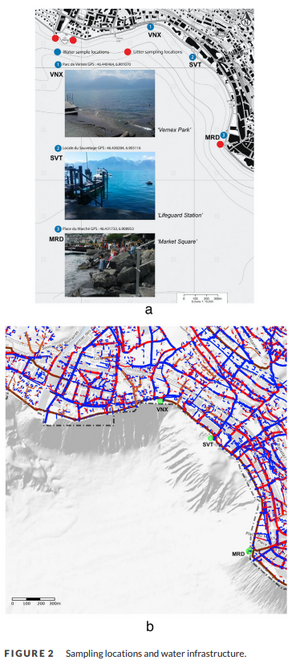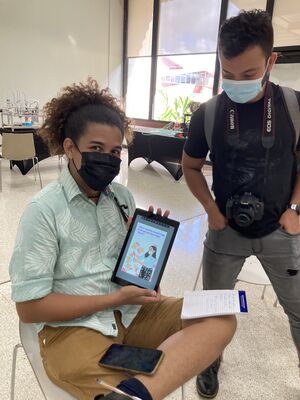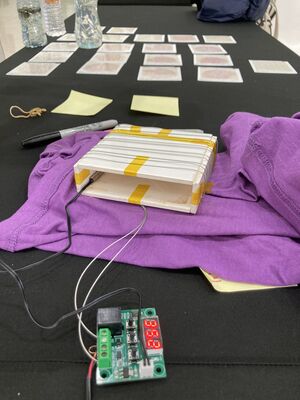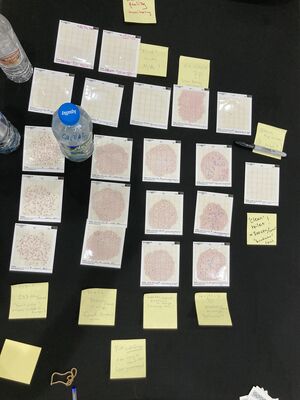Difference between revisions of "MCBP Campaign 2022"
| Line 47: | Line 47: | ||
on the last day of #GOSH, Harold crimped bits onto the wires, to make it more stable for its travel back to Switzerland... | on the last day of #GOSH, Harold crimped bits onto the wires, to make it more stable for its travel back to Switzerland... | ||
| − | Imagine the volume that would be needed with real petri dishes and that many samples! At least 10-20x, I guess... | + | Imagine the volume that would be needed with real petri dishes and that many samples! At least 10-20x, I guess... |
| + | viva open science hardware and these cool cards! | ||
| − | + | (See pictures and results with Canal water, etc., to right.) | |
| − | ( | ||
<nowiki>***</nowiki>To note: for higher temps, want different wire without the coating!!! | <nowiki>***</nowiki>To note: for higher temps, want different wire without the coating!!! | ||
| − | + | [[File:Artisticimpression.JPG|thumb|#GOSH2022 team's artistic impression of the workshop]] | |
| − | + | [[File:Postincubation.JPG|thumb|Workshop finale in Panama. The DIT-incubator kept its temperature and fit all those cards!]] | |
| − | + | [[File:Results waterquality.jpg|thumb|Overview of the results.]] | |
Revision as of 11:01, 4 November 2022
The Montreux Clean Beach Project began in 2016, with friends from Hammerdirt and BIO-DESIGN for the REAL WORLD, and addressed issues of lake water pollution in the face of transient population increases.
Here is the link to the old project page, which leads to a great deal of information, and ultimately led to our peer reviewed article and open data archive on this work...
The sampling work continued in the summer of 2022, using a new card format for the microbiological testing.
With a wonderful participatory research team, and kind collaboration of people organising the Montreux Jazz, we did 6 replicates (each obtained in their own tubes) from each of the usual three sites around the bay (depicted in the figure to the right) over an 8-week period.
We learned a great deal, also sampling from the off-shore platform, LéXPLORE!
With first hints of fall already in the air, after a crazy summer of record heat, we were pulling together the open data, and hoping to get the official beach sampling data to compare to our findings. Attempts at communication with the Montreux 'powers-that-be' and the other authorities and groups and people involved in water quality surveillance were never satisfactory, unfortunately, although we still hope to get the official results of their Clarens beach sampling.
Here is the preliminary first overview of the average bioindicator and coliform levels per 100ml of water sample, week by week.
Here is a compilation of further graphs, also including the rain data.
As there was no rain between the 6th and the 18th of July, we wonder whether this could explain the unexpected reduction of bioindicator levels during the Jazz in 2022?
We invited everyone to learn more by coming to the big #OpenHackuarium Event:
MCBP2022 Wrap, 19h30, 12 October
Route de Crochy 20, 1024 Ecublens
There was so much more to bring together, with data from the platform, the Clarens beach, and another STEP, too...
Here is the presentation from that special #OH evening.
The python coding and putting together the open archive are already in progress and will be shared soon.
(To note, because 1ml was the max inocula for these cards, the limit of detection is 100/6 - or about 17 colonies/per 100mls water... These charts actually should never go down to 0! ;P)
Please let us know if you are interested in pursuing more of such work, out in the field or in the lab... =)
Water Monitoring at GOSH 2022
With extra cards from the MCBP2022 campaign, the people at #GOSH2022 were introduced to Microbiological Water Monitoring!
It was amazing.
Harold Tay made a super simple incubator the first day of the gathering that could stably hold the 35 degree Celsius temperature needed *** for the R-Cards out of some old bathroom tiles, nylon-coated steel wire, and a simple thermostat, the W1209.
A masonry bit was used to score the glazed portion of the tile, breaking it into 3. This allowed a whole stack of R-cards to be put inside for the 48h incubation.
Epoxy glue was used to glue these the tile pieces together.
on the last day of #GOSH, Harold crimped bits onto the wires, to make it more stable for its travel back to Switzerland...
Imagine the volume that would be needed with real petri dishes and that many samples! At least 10-20x, I guess...
viva open science hardware and these cool cards!
(See pictures and results with Canal water, etc., to right.)
***To note: for higher temps, want different wire without the coating!!!
/
Le projet Montreux Clean Beach a débuté en 2016, avec des amis de Hammerdirt et BIO-DESIGN for the REAL WORLD, et a abordé les questions de la pollution des eaux du lac face à l'augmentation de la population transitoire.
Voici le lien vers l'ancienne page du projet, qui mène à de nombreuses informations, et finalement à notre article revu par les pairs et aux archives de données ouvertes sur ce travail....
Le travail d'échantillonnage a re-commencé pendant l'été 2022, en utilisant un nouveau format de cartes pour les tests microbiologiques.
Avec une merveilleuse équipe de recherche participative, et l'aimable collaboration des personnes qui organisent le Montreux Jazz, nous avons fait 6 réplicats (chacun obtenu dans ses propres tubes) de chacun des trois sites habituels autour de la baie sur une période de 8 semaines.
Nous avons beaucoup appris, en prélevant également des échantillons sur la plateforme en mer LéXPLORE.
Avec les premiers signes de l'automne déjà dans l'air, après un été fou de chaleur record, nous rassemblions les données ouvertes et espérions obtenir les données officielles d'échantillonnage des plages pour les comparer à nos résultats. Les tentatives de communication avec les autorités de Montreux et les autres autorités, groupes et personnes impliqués dans la surveillance de la qualité de l'eau n'ont malheureusement pas été satisfaisantes, bien que nous espérions toujours obtenir les résultats officiels de l'échantillonnage de la plage de Clarens.
Voici le premier aperçu préliminaire des niveaux moyens par 100ml de bioindicateurs et de coliformes trouvés, semaine par semaine.
Voici une compilation d'autres graphiques, incluant également les données de pluie.
Comme il n'y a pas eu de pluie entre le 6 et le 18 juillet, nous nous demandons si cela pourrait expliquer la réduction inattendue des niveaux des bioindicateurs pendant le Jazz en 2022 ?
Nous avons invité tout le monde à en savoir plus en venant au grand événement #OpenHackuarium :
Sommaire de MCBP2022, 19h30, 12 octobre
Route de Crochy 20, 1024 Ecublens
Il y a plus à rassembler, avec les données de la plateforme, la plage de Clarens et encore une STEP, aussi...
Voici la présentation de cette soirée portes ouvertes (#OpenHackuarium).
Le codage python et le montage de l'archive ouverte sont en cours et seront bientôt partagés.
(A noter, comme 1ml était l'inocula maximum pour ces cartes, la limite de détection est de 100/6 - ou environ 17/par 100mls d'eau... En fait, ces graphiques ne devraient jamais descendre à 0 ! ;P)
N'hésitez pas à nous faire savoir si vous êtes intéressés à poursuivre ce genre de travail, sur le terrain ou en laboratoire... =)
Surveillance de l'eau à GOSH 2022
Grâce aux cartes supplémentaires de la campagne MCBP2022, les personnes de #GOSH2022 ont été initiées à la surveillance microbiologique de l'eau !
C'était incroyable.
Le premier jour du rassemblement, Harold Tay a fabriqué un incubateur très simple, capable de maintenir de manière stable la température de 35 degrés Celsius nécessaire pour les cartes R, à partir de vieux carreaux de salle de bain, de fil d'acier recouvert de nylon et d'un simple thermostat, le W1209.
Une mèche de maçonnerie a été utilisée pour entailler la partie vitrée du carreau, le cassant en 3, ce qui a permis de placer une pile entière de cartes R à l'intérieur pour l'incubation de 48 heures.
De la colle époxy a été utilisée pour coller les morceaux de tuiles ensemble.
Le dernier jour de #GOSH, Harold a serti des morceaux sur les fils, afin de les rendre plus stables pour le voyage de retour en Suisse...
Imaginez le volume qui serait nécessaire avec de vraies boîtes de Pétri et autant d'échantillons ! Au moins 10-20x, je suppose... viva le matériel scientifique ouvert et ces cartes cool !
(à confirmer et ajouter des photos et résultats avec l'eau du canal etc...)
À noter : pour des températures plus élevées, il faut un autre fil sans recouvrement de nylon !!!



